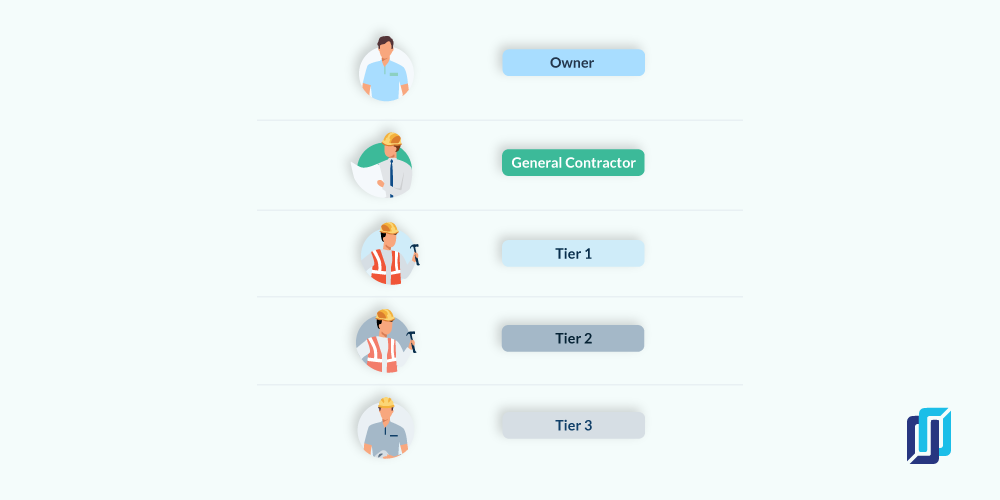
In most circumstances, it’s easy to determine your role and tier in a construction project. It is possible, however, to encounter confusion and difficulties with this simple question. Since the question is key to inputting a job into the Levelset system, or more generally to properly preparing your lien rights, it is an important one.
Tier & Role Is Key To Your Mechanics Lien Rights
Let me first explain why knowing your tier and role is important in the mechanics lien and bond claim context. Mechanics lien and bond claim laws are written to balance the rights of various parties on the project. Preliminary notices are required to notify the owner (and sometimes the general contractor) about who is on the project to avoid hidden or surprise liens. Further, only some tiers of contractors and suppliers are protected because the laws consider lower tiers to be too far removed from the owner to make it have a chance at liability. In the balance of all these parties’ rights, there are lots of decisions made and requirements set forth based on the role and tier of the parties. Material suppliers and equipment lessors, for example, are frequently treated differently than subcontractors and tradespeople.
This is the case in Louisiana, for example, where preliminary notices are required from both of these roles, but not for anyone furnishing any type of labor to the project (i.e. a subcontractor). Differing tiers experience differing treatment as well. As we’ve written about in the past, for example, suppliers to suppliers are usually without lien rights. The further down you are in the contracting chain, the less likely you are to have any rights to file a mechanics lien. More than separating the haves from the have nots in lien-rights speak, your tier on a project also determines who you must send notice to. A subcontractor to the prime contractor probably only needs to give notice to the owner. But a subcontractor to a subcontractor (a sub-sub), likely needs to send notice to the owner and the general contractor.
How To Determine Your Role and Tier – Tips And Frequently Encountered Issues
It’s clear now (yes?) that your role and tier is important to know when protecting your mechanics lien rights. Now the question is how do you determine your role and tier? In 99% of the cases, as I alluded to above, the issue is very simple. It is usually very clear whether you are the prime contractor, the subcontractor, the sub-subcontractor or the material supplier. It’s similarly clear whether you are on the first tier (sub to prime) or the second tier (sup or supplier to sub), and so on.

Here are some frequently encountered issues, however, that make the question hazy.
1) Joint Ventures or Assignments of Contract
Sometimes, identifying who is the exact general contractor can be a complex affair. On larger projects, multiple general contractors sometimes get together and form a joint venture, or a contract may be so big that the project has multiple general contractors. Or, in more complex situations, the general contractor doing the work may have actually been contracted by the general contractor who bid the project. The problem with all of these situations, however, is the same: You don’t know exactly what the agreement is between the parties, and you don’t know exactly who contracted with the owner.
Determining who contracted with the owner is the ultimate question because that is what marks that party as the direct or primary contractor. Call that party what you will, and throw in as many confusing issues as you’d like, but the analysis is still the same: The party who contracted with the owner is the direct or primary contractor. If you can’t figure out who this is, you may need to make some guesses or make a formal request for the party to be identified to you. Research of who the general contractor is and making the formal request can be performed for you by Levelset .
2) Owner / Builders or Owner / GCs
This question came up the other day from a Levelset client. A client was on a project where the owner was “acting” as the GC. So, when asked to choose whether they were hired by the owner or hired by the GC, they became confused. Further confusing is then how do they identify themselves: as the general contractor? as a subcontractor? The trouble here is that the terminology is confusing, but the situation is not. Go back to our golden rule: The party who contracts with the owner is the direct or primary contractor. Period. It doesn’t matter whether the work performed is “subcontractor” or “trade” type work. It doesn’t matter if there are 50 other parties contracting with the owner. If the party contracts with the owner, they are the GC. The “Owner / GC,” therefore, is simply the owner.
3) Lower Tiered Parties Don’t Know Details Of Contracting Chain
We alluded to this issue above in the first frequently encountered issue: Some parties on the project simply do not have good information. This is frequently the case for material suppliers (who are oftentimes out of town and never step foot on the job site) and for low tiers. The trouble here isn’t confusion, but it’s simply a lack of information and a lack of access to that information. Unfortunately, the lower tiers and material suppliers frequently without this information are the parties who need it the most. Again, if you can’t find it, you may need to make some presumptions and request it.


